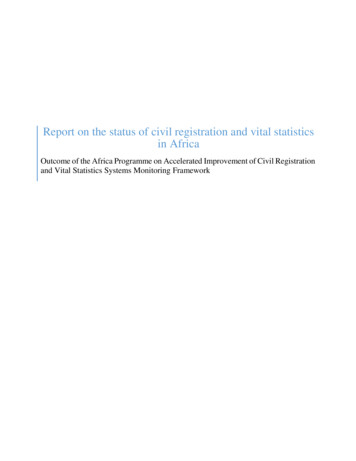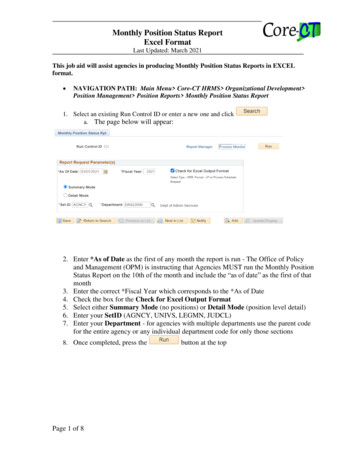
Transcription
Report on the status of civil registration and vital statisticsin AfricaOutcome of the Africa Programme on Accelerated Improvement of Civil Registrationand Vital Statistics Systems Monitoring Framework
Executive SummaryThe systematic and coordinated implementation of the Africa Programme on AcceleratedImprovement of Civil Registration and Vital Statistics (APAI-CRVS) has helped to buildsignificant momentum towards the improvement of civil registration and vital statistics systemson the continent. The political commitment at the national level coupled with regional technicaland capacity-building support for countries has brought a paradigm shift from a fragmented andad hoc approach to a more holistic and integrated improvement of CRVS systems in member states.More than half of the countries have conducted assessment, some have developed strategic plansand few of them have begun to implement their improvement plans. Despite the remarkableprogress achieved in the past few years, there remain a number of major challenges facing theAfrican CRVS systems.This monitoring report was prepared based on the APAI-CRVS web-based monitoring resultsconducted in October 2016 to measure the progress achieved by each country in various aspectsof civil registration and vital statistics systems. The report presents summary of the findings basedon responses obtained from 39 countries out of the 54 member states expected to fill-in the onlinemonitoring form, which makes 72% response rate. The findings provide a broad overview on thestatus of national CRVS systems and help to identify strengths and weakness of differentcomponents of CRVS systems.The followings are the key findings:i.All countries in the region, except South Sudan, have laws and legal provisions for civilregistration. However, in many countries the existing laws are outdated and not aligned tothe recommended international standards. In more than one-third of the countries, the civilregistration law does not distinguish late and delayed registration. Registration of marriageand divorce are not compulsory in many countries. The monitoring result shows thatdivorce registration is compulsory only in 17 out of the 39 countries completed themonitoring questionnaire. Nearly half of the countries (46%) have no legal provision fortransferring of data from civil registration offices to a government agency in charge ofcompiling national vital statistics and producing annual report.ii.Most of the countries responded to the monitoring survey indicated that the nationalgovernment allocate budget for the maintenance of the civil registration system.Nonetheless, more than two-thirds of the countries reported that the government budget iseither inadequate or irregular. For five countries, the government does not make budgetaryallocation for the civil registration system.iii.The monitoring result shows that only 11 countries (28%) have adequate human resourceat all levels of their CR system, yet for 27 countries (67%) their human resource isinadequate at the local registration offices. More than half of the countries have no routine1 Page
training schedule for civil registrars and trainings are conducted occasionally in an ad hocbasis.iv.Nearly three-quarter (74%) of the countries have constituted high-level coordination bodyto oversight and provide guidance for national CRVS systems, but the coordination systemis not effective in half of these countries. Although many countries have a formal interagency committee to facilitate CRVS operations, the collaboration remains to beinsufficient.v.Some countries charge fees for vital events registrations in legally specified time and forissuing first copy of a certificate. Monitoring result shows that fees are charge for currentregistrations of birth and deaths in 5 and 9 countries, respectively. More countries chargefees for marriage (21 countries) and divorce (14 countries) registrations. In manycountries, customers requiring registration certificate have to pay fees to get first copy ofthe certificates, for birth and death in 14 countries and for marriage in over 20 countries.vi.About half of the countries have fully or partially computerized civil registration system;whereas a large number of countries are still fully depend on paper-based registrationsystem. One-third of the 39 countries capture birth and death records electronically at alllocal registration offices. Only few countries employ mobile phone technology to notifybirth and death occurrences at home or in health facilities.vii.The monitoring result reveals that 29 out of the 39 countries have national identificationdatabase and 20 countries maintain computerized database on civil registration records.However, the two systems are interoperable only in 13 countries.viii.The result indicates that only 13 countries (33%) use the standard international form tocertify cause of death and apply the latest version of the ICD-10 for coding of cause ofdeath.ix.Only few countries compile annual vital statistics and compute completeness of vital eventsregistered in a given year. According to the monitoring results, the regional averagecompleteness rate of birth registration has increased from around 40% to 56% from 2012to 2015, while completeness of death registration remained below 40 percent.In conclusion, countries in the region show wide variation in their civil registration and vitalstatistics systems. In some of the countries, the existing civil registration laws are outdated andhave not been reviewed and aligned to the international standards. Countries have different levelsof registration coverage and completeness. Only few countries compile and produce annual vitalstatistics report from civil registration, while most of the countries do not use registration recordsto compile vital statistics. There is also lack of effective coordination and collaboration betweenstakeholders at national level, civil registration systems are underfunded and understaffed.2 Page
Registration services are inaccessible to people living in rural areas and the quality of servicesremain poor, therefore the coverage and completeness of civil registration are very low in most ofthe countries. The use of modern technology has only progresses piecemeal and databases oncitizen records such as civil registries, health information systems and national ID systems are notintegrated. Death registration are particularly challenging and many countries perform poorly oncompleteness of death registration and medical certification of cause of death.There is a need to pay particular attention on the five poorly functioning components of CRVSsystems for most of the countries: budgeting and human resource, coordination and monitoring,use of ICT and digitization, recording of cause-of-death, and producing vital statistics from civilregistration.I. Introduction1.1 BackgroundCivil registration and vital statistics is an essential administrative system in modern society. Thecivil registry provides individuals with essential legal documents required to secure their identity,nationality and civil rights and access to social services. Well-functioning civil registration andvital statistics systems are crucial for creating inclusive societies, ensuring proper delivery ofpublic services and realizing and protecting basic human rights of all individuals. In general,building viable and universal civil registration and vital statistics systems help to make everyonein Africa visible, protect human rights and address inequalities. Compilation and analysis of vitalstatistics from civil registration are critical for estimating annual changes in population size andstructure, and for planning and monitoring social programmes, such as health, education andpopulation intervention. Comprehensive, accurate and timely vital statistics are also essential formonitoring and reporting regularly on the progress in achieving he globally agreed developmentgoals of the 2030 Agenda for Sustainable Development and implementing the regional Agenda2063: The Africa We Want, which calls for a united, prosperous and peaceful Africa.Even though these values of civil registration and vital statistics systems are well-recognized,many African countries do not have properly functioning civil registration and vital statisticssystems. Only four countries (Egypt, Mauritius, Seychelles and South Africa) have managed tomaintain a compulsory and universal registration system that meets international standards,including a satisfactory level of registration coverage and completeness of recording vital eventsand information on cause of death.1 During the last few years, in recognizing the poor status civilregistration and vital statistics systems in the region, African States have stepped up their effortsto improve their civil registration and vital statistics systems through regional initiatives.1Report of regional assessment study of Civil Registration and Vital Statistics Systems in Africa, UNECA, September 2012. SeeE/ECA/CMRCR/S/EXP/6.3 Page
The first step of regional initiatives began in June 2009 in an expert group workshop held in Daras-Salaam. The experts recognized that civil registration and vital statistics is multisectoral andmultidisciplinary in nature and can be strengthened only through a holistic and integratedapproach, and identified political commitment as the first major step towards this end. Followingthe First Conferences of Ministers responsible for Civil Registration and Vital Statistics held inAugust 2010, in Addis Ababa, regional institutions were constituted to coordinate and advancecivil registration and vital statistics policies in Africa. The Regional CRVS Core Group wasestablished in early 2011, and, in July 2012, the Ministerial Conference was endorsed as apermanent biennial conference under the auspices of African Union Commission. In 2012,the Second Conference of Ministers launched a regional programmatic framework known as theArica Programme on Accelerated Improvement of Civil Registration and Vital Statistics(APAI-CRVS) to steer the regional initiate to improve civil registration and vital statistics. Thesecretariat of Programme was established under the leadership of the Economic Commissionfor Africa (ECA) to coordinate and provide programmatic guidance to the regional agendato reform and improve civil registration and vital statistics systems. The Third Conference ofMinisters responsible for Civil Registration, held in 2015, passed a number of crucialresolutions and recommendations to strengthen and accelerate the initiative to improveregional civil registration and vital statistics systems in Africa. In June 2016, member Statesdeclared 2017-2026 as the “Decade for repositioning of civil registration and vital statistics inAfrica”.The African Programme on Accelerated Improvement of Civil registration and Vital Statisticsprovides management and programmatic guidance to the efforts aimed at carrying out the regionalagenda of reforming and improving civil registration and vital statistics systems on the continent.The Programme, which is guided by policy directives set by the biennial Conference of Ministersand steered by the Regional Core Group, is the regional body for bringing together various civilregistration and vital statistics initiatives into a common and consolidated policy and advocacyframework. A five-year strategic plan for the period 2017-2021 has been developed by theProgramme to serve as a guiding tool for countries, regional and international organizations inmanaging interventions and monitoring progress related to the civil registration and vital statisticssystems in Africa.The systematic and coordinated implementation of the Africa Programme on AcceleratedImprovement of Civil Registration and Vital Statistics Systems since 2010 has helped to buildsignificant momentum towards the improvement of civil registration and vital statistics systemson the continent. The political commitment at the national level coupled with regional technicaland capacity-building support have helped countries make a paradigm shift from a fragmented andad hoc approach to more holistic and integrated efforts. More than half of the African countrieshave conducted a comprehensive assessment of their civil registration and vital statistics systems,and some of them have developed action plans to address gaps identified through the assessmentand accelerate improvement of national civil registration and vital statistics systems.4 Page
Despite the remarkable progress achieved in the past few years, there remain a number of majorchallenges facing the African civil registration and vital statistics systems. Some countries do nothave in place comprehensive civil registration laws that are aligned with international standardsand in many of these countries, the laws have not been revised for decades. In many countries,civil registration and vital statistics systems are underfunded and understaffed. Registrationservices are inaccessible to people living in rural areas and the quality of services remain poor,therefore coverage and completeness of civil registration are very low in almost all countries.There is no efficient coordination and collaboration among the civil registration and vital statisticssystem stakeholders at the national level. The use of modern technology has only progressedpiecemeal in many countries and databases on citizen records, such as civil registrars, nationalidentification systems, population registers and voter registration systems are not linked with eachother. Only a few countries compile and produce annual vital statistics report from civilregistration. Death registration and cause of death information are particularly challenging formany countries in the region.The first step to improve civil registration and vital statistics systems is to review the functionalityof the current systems. However, most of the countries in the region do not have a system toroutinely monitor the development of their civil registration systems and therefore cannotadequately report on improvements and challenges emerging from the interventions. There is anincreasing need for a robust system to measure and monitor progress and challenges in theimplementation of the African Programme on Accelerated Improvement of Civil Registration andVital Statistics at the national level. At their second conference the African Conference of Ministerresponsible for Civil Registration recommended to “develop results-based monitoring andevaluation systems and tools to monitor and report on progress on civil registration and vitalstatistics” in the region.2 Responding to this call, the African Programme on AcceleratedImprovement of Civil Registration and Vital Statistics developed a web-based platform todocument the status and monitor the progress made by member states on their civil registrationand vital statistics systems. This monitoring exercise was launched on the Programme’s websitein October 2016; the online form was to be filled by a designated focal point from the country’scivil registration office and submitted through the website.1.2 Objectives of the monitoring surveyThe purpose of the monitoring survey is to review the status of civil registration and vital statisticssystems in African countries based on data received from them through a web-based onlinequestionnaire filled in by focal points in the country. The monitoring platform is intended tomeasure the progress achieved by each country on various aspects of civil registration and vitalstatistics systems in the context of the Programme’s initiatives. This is the first exercise of theweb-based monitoring process that will allow countries to correct and update their current statusin this area in subsequent years.The specific objectives included the following:2See terial%20Statement Eng 0.pdf.5 Page
To assess the current status of civil registration and vital statistics systems in memberStates;To create a regional database on the status of the systems in Africa;To provide baseline information for monitoring the progress in the implementation ofthe Programme’s five-year strategic plan for the period 2017-2021;To develop a regional dashboard that will present a more detailed status of progress invarious aspects of civil registration and vital statistics in Africa.To assist countries in taking stock of the status of their civil registration and vital statisticssystems and share experiences on best practices and challenges in implementingimprovement plans;To assist in preparing evidence-based reports for the biennial Ministerial Conference oncivil registration and vital statistics improvements and challenges.1.3 Structure of the monitoring questionnaireThe questionnaire consists of three parts: Part A focused on the civil registration system legalframework, which contained 11 multiple-choice questions assessing the state of the legalframework governing registration of vital events within the country or the production of vitalstatistics based on civil registration records. Part B deals with the organization and functioning ofthe civil registration and vital statistics system with 74 multiple-choice questions on topics relatedto: (i) civil registration infrastructure, coordination and resources; (ii) civil registration and vitalstatistics processes and services; (iii) use of civil registration documents and vital statisticsgenerated from civil registration (iv) causes of death practices; (v) data quality and plausibilitychecks; and (vi) data access, dissemination and use. Part C focuses on the completeness ofregistration of vital events. Filling this part requires collecting data on annual number of registeredvital events, population size and basic demographic rates for the four years (2012-2015), precedingthe monitoring survey.1.4 Administration of the monitoring formThe form is a web-based platform to be filled in online, once a year, and submitted through thewebsite by the designated focal point, who has the account on the portal and appropriate accessrights to submit the form on behalf of the country. Although only the designated focal point cansubmit the form, the monitoring exercise is a collaborative effort in which all main nationalstakeholders are involved. This is emphasized to ensure that the answers best reflect the status ofthe civil registration and vital statistics improvement process in the country in all aspects. Theform is filled out on the website only after consultations with all the national stakeholders.1.5 Response rate and data qualityOut of the 54 member States expected to fill out the online monitoring form, 39 countries havecompleted the questionnaire, which constitutes, about a 72-per cent response rate. Fifteen countrieshave failed to submit the questionnaires, despite follow-up reminders from African Programme onAccelerated Improvement of Civil Registration and Vital Statistics secretariat, In addition to nonresponses, there are also some incomplete and inconsistent responses by countries. However, in6 Page
most cases the incomplete and inconsistencies have been corrected through follow upcommunications by the secretariat to the respective countries. The major deficiencies observed onpart c of the questionnaire in which countries are requested to provide data on annual number ofregistered vital events, population size and basic demographic rates inputs to computecompleteness of registration. Only less than half of the 39 countries have submitted vital statisticsdata required for calculating the level of vital events registration completeness. This indicates thatmore effort is needed by countries and the secretariat to improve the response rate and accuracy ofthe data.1.6 Methods of data analysisEach of the questions with multiple answers has two to four scenarios for countries to choose fromthat best describes their civil registration and vital statistics ( the questionnaire available at:www.apai-crvs.org ). In this report, simple frequency distributions of aggregated responses arepresented and described. In addition, summary indicators have been computed to measure the levelof functionality of the civil registration and vital statistics components, components, such as thelegal framework, planning and coordination, resources and infrastructure.To compute a summary indicator for each major component of civil registration and vital statisticssystems, each scenario is assigned a numeric value ranging from 0 to 1. The numeric value of 0represents a situation that is not compliant with the standards-based practices orstatus, while 1stands for a situation or practice that is fully compliant with the standards; for a partially compliantsituation, a fraction is assigned. The aggregated values across all question items under eachcomponent provides the overall score, which helps to clearly convey the status of a component ofthe civil registration and vital statistics systems for each country. In terms of percentage score, itranges from 0 to 100, a score closer to 0 implies a “very weak” system while a high score indicatesa “strong” system.1.7 Structure of the reportThis present report comprises four sections divided into subsections. The first section is anintroduction section, in which background information, structure and the process of the monitoringexercise is provided. In section two, the results on institutions, resources and registration processunder subsections: legal framework; infrastructure and resources; planning, coordination andmonitoring; registration process; uses of information and communications technology (ICT); andcause of death, are presented. The third section includes the results on completeness of birth anddeath registration; vital statistics and data quality checks; and uses of registration documents andvital statistics data. Finally, section four contains the conclusion and way forward.II. Institutions, resources and registration process7 Page
This section highlights major findings on the status of national civil registration and vital statisticssystems and their components, including the legal framework, coordination mechanisms,infrastructure, resources, and registration and certification processes. The results are presented insubsections based on the major components of the systems for member States that have completedthe monitoring survey.2.1 Legal frameworkThe legal framework is a critical primary step to ensure a continuous, permanent, compulsory anduniversal civil registration system. The establishment, efficient management, operation andmaintenance of the registration system cannot be realized without proper legislation andmechanisms designed to enforce it nationwide.3Most countries have in place some legal provisions for governing their civil registration system.Table 2.1a shows the number of countries that have legal provisions under their law to registervital events. The monitoring result indicates that 38 out of the 39 countries that completed themonitoring form have civil registration laws for recording birth and death. South Sudan is thecountry lacking legal provision for birth and death registrations. Notably. legal provisions for civilregistration do not equally address the four priorities of vital events (birth, marriage, divorce anddeath). While the law in most countries covers the registration of birth and death, the resultindicates that 10 out of the 39 countries do not have legal provisions for registration of divorce.Table 2.1a: Distribution of countries by legal provisions on civil registrationsVital nlawYesNo381381372291039All segments ofpopulationcoveredYesNo37237235435439The law iscompulsoryYes3737332239No22617Law distinguishlate and tional legal provisions should call for universal and compulsory registration of vital events toensure coverage of the entire population in the country, regardless of geographic location andsubdivisions of the population. The result indicates that civil registration laws in a majority of thecountries (37 out of 39) provide provisions for compulsory registration of birth and death.However, despite having legal provisions for universal and compulsory registration, it does notnecessarily mean that countries enforce the law and actually covers the entire population in allgeographic locations within their respective territories. Unlike birth and death, registrations of3 rinciples/M19Rev3en.pdf8 Page
marriage and divorce are not compulsory in many countries. The provision of compulsoryregistration of divorce is not particularly common, only 17 out of the 39 countries have in placesuch legal provisions.Civil registration law should include the time period within which each vital event should beregistered after occurrence. It is important to specify the duration of registration and distinguishbetween late and delayed registration in order to maintain continuous and timely recording of vitalevents. Registration of an event within a legally stipulated time period is called currentregistration. If the registration of a vital event occurs after the legally specified time period butwithin one year after occurrence, it is called late registration. Whereas, if the registration takesplace later than one year after the occurrence of the event, it is referred as delayed registration.As shown in table 2.1a, civil registration law in many countries does no fully distinguish betweenlate and delayed registration for vital events, particularly for marriage and divorce. Out of the 39countries, civil registration law that distinguishes late and delayed registration for birth and deathis indicated in 26 and 24 countries, respectively, while for registrations of marriage and divorce,the distinction is apparent in only 11 and 8 countries, respectively.Civil registration law should contain a provision for the transmission of records of vital eventsfrom civil registration offices to vital statistics compiling office. The registration law needs also tobe accompanied by legislation that defines responsibilities for collection, processing anddissemination of vital statistics from civil registration. Table 2.1b presents the number andpercentage of countries that have legal provisions for the transmission of vital records andresponsibilities for processing and dissemination of vital statistics. The result indicates that nearlyhalf of the countries (46 per cent) that completed the monitoring form have no legal provision forthe transmission of data from civil registration offices to a government agency entrusted withcompiling national vital statistics. Out of the 39 countries, 22 countries (56 per cent) have adequatelegislation for defining the responsibilities on all vital statistics process, including compiling,processing and the dissemination of vital statistics for civil registration.Additionally, cause of death is key information that should be collected in a civil registrationsystem. Cause of death, if entered in the death reporting form and certified by trained medicalpractitioners, is important for legal purposes and planning and monitoring of national healthprogrammes. According to the monitoring results from the 39 countries, almost 50 per cent (20countries) have reported that they enacted legislation on cause of death certification using theWorld Health Organizations (WHO) standard form. While for the remaining countries, either theirlegislation does not adhere to the standard form or indicating cause of death is not required. at all.Among countries that have in place legislation on cause of death certification that conforms withthe WHO standard, only a few of them apply the International Classification of Disease codes andcertification, as indicated in the following section.9 Page
Table 2.1b: Distribution of countries by legal provisions on vital statistics and cause-of-death certificationNumber ofCompiling vital statistics/ cause-of-death certificationcountries%Does the law make a provision for the transmission of civil registration data from registration offices tothe vital statistics compiling office?Yes, include provisions for vital statistics data transmission2153.8No, does not include provisions for vital statistics data transmission1846.2Total39100Does the country have legislation that defines responsibilities for the collection, processing anddissemination of vital statistics from civil registration?Yes, has adequate legislation defining responsibilities on all of the vital statisticsprocess2256.4Yes, has legislation but does not mention all stages of the vital statistics process923.1No legislation defining responsibilities for the vital statistics process820.5Total39100Does the country have legislation stating that death has to be certified by cause and specify it in theregistration form?Yes, has legislation on certification of death by cause using the WHO standard form 2051.3Yes, cause of death must be indicated on certificate but not using the WHO standard 717.9No, cause of death should be indicated but death certification form not specified717.9No, it is not necessary to indicate the cause of death at all512.8Total39100In addition to presenting the results on the 11 individual questions assessing the state of the legalframework governing civil registration and vital statistics, it is also important to examine thesummary indicator on legal framework for civil registration and vital statistics systems. Thesummary indicator provides a score on the level of functionality and helps to clearly communicatethe status of countries’ legal frameworks for civil registration and vital statistics systems. Thescore ranges from 0 to 100; countries with a low score implies a “weak” legal framework while a
use of ICT and digitization, recording of cause-of-death, and producing vital statistics from civil registration. I. Introduction 1.1 Background Civil registration and vital statistics is an essential administrative system in modern society. The civil registry provides individuals with essential legal documents required to secure their identity,











